Salesflow Alternatives
Looking for a Salesflow alternative? This guide compares 10 tools, analyzing features, pricing, and performance to help you find a replacement.

Many sales teams use Salesflow for good reason. It helps automate LinkedIn prospecting and manage campaigns. Users often praise its ease of use and strong LinkedIn integration, which makes it a solid choice for lead generation.
However, some users report occasional issues with data accuracy or a poor design. This might make you consider other options. We analyzed the top alternatives based on G2 reviews to help you find the right fit. Let's get started.
Consider 11x for Your Sales Team
If you are exploring digital workers for your sales team, 11x offers AI agents designed for sales functions. This could be a suitable option for companies that want to add autonomous capabilities to their sales process.
11x is a GTM platform with AI agents that handle the sales process. Its agent, Alice, finds prospects, conducts email and LinkedIn outreach, and updates your CRM.
Another agent, Julian, qualifies inbound leads and books meetings. The platform unifies data enrichment, outreach, and email warmup tools, so separate solutions are not required.
Salesflow Alternatives
This section provides a detailed breakdown of popular Salesflow alternatives. We compare each tool's pricing, core features, and its relative strengths and weaknesses to help inform your choice.
1) Expandi
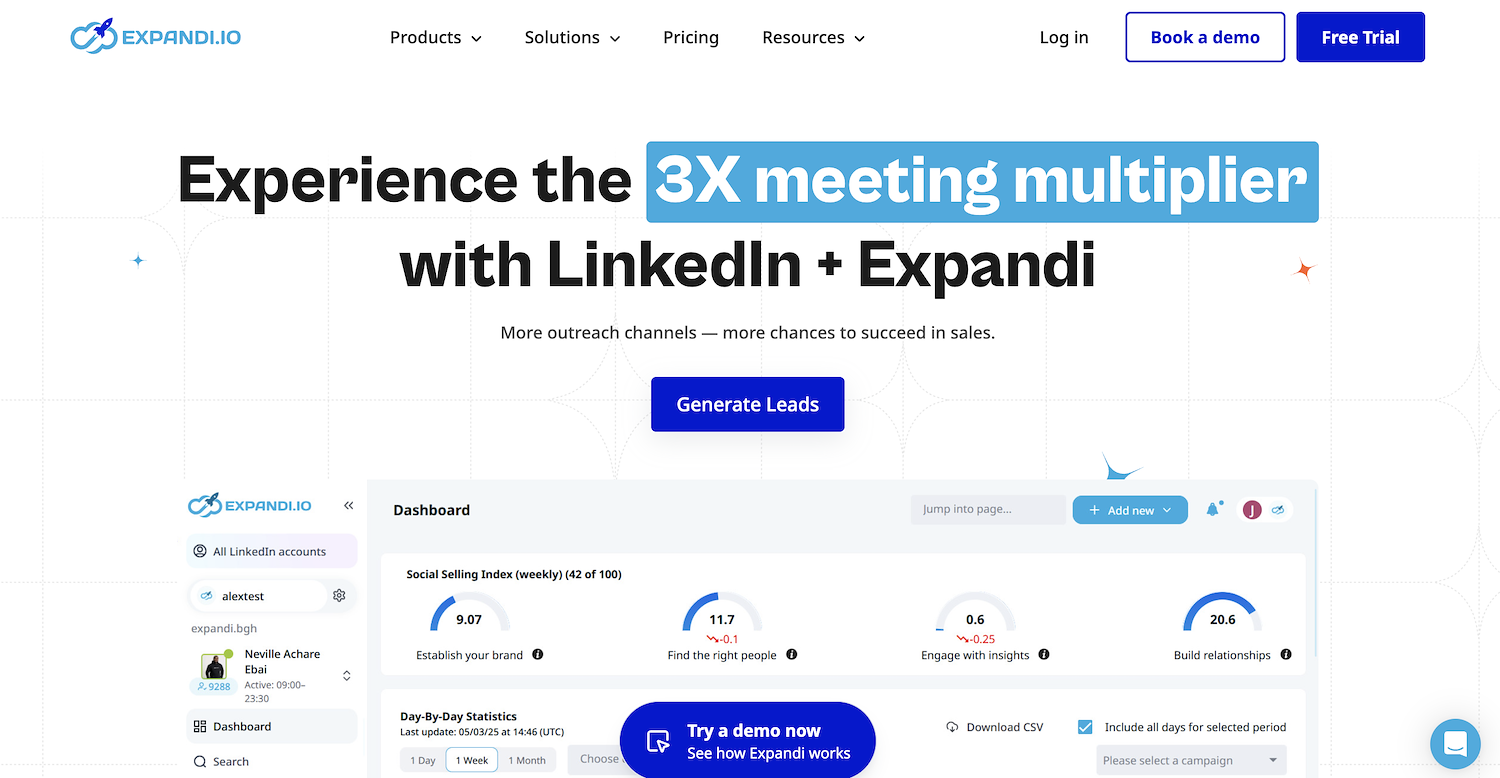
Expandi is a cloud-based platform for LinkedIn automation and multichannel outreach. It combines LinkedIn and email into automated sequences to support lead generation. The tool helps with cold outreach and automated follow-ups.
It allows users to send up to 300 connection requests per week. The platform scrapes data from groups, events, and posts for personalization. A campaign-priority engine helps allocate daily LinkedIn limits to top performers.
Expandi's Main Features
- Builds visual drag-and-drop flows with 10 actions and 10 conditions, including pre-outreach warm-up actions like profile visits.
- Inserts dynamic images, videos, and GIFs into messages through direct integrations with Sendspark and Hyperize as a paid add-on.
- Manages multiple LinkedIn accounts from a single login with shared dashboards, roles, and permission management for teams.
How Expandi Compares To Salesflow
Average Review Score: 4.2/5 stars based on 113 G2 reviews.
- Expandi provides an omnichannel approach by combining LinkedIn and email outreach, whereas Salesflow primarily focuses on LinkedIn automation.
- Its smart campaign builder includes pre-outreach actions like profile visits and endorsements, offering a different type of sequence compared to Salesflow.
- The tool supports dynamic personalization with images and GIFs through integrations, a feature not standard in Salesflow that can help messages stand out.
- It offers specific features for LinkedIn events, such as messaging attendees, and scrapes data from groups for more targeted prospecting.
Where Expandi Falls Short Compared To Salesflow
- Salesflow provides dedicated campaign management tools. In contrast, some users report that lead management in Expandi can be less straightforward, occasionally requiring more manual effort to track prospects.
- The platform sometimes experiences delays that can impact the timing of outreach. Salesflow’s focused approach on LinkedIn automation typically provides more consistent performance without these reported lags.
- Its omnichannel capabilities, while robust, may add complexity for teams that only need LinkedIn automation. In this case, Salesflow's singular focus presents a simpler and more direct user experience.
Pricing and Budget Considerations
Salesflow is described as an affordable tool, while user reviews indicate Expandi has a high perceived cost. Since neither provides a public price list, visiting their official websites is the best way to get accurate pricing information.
2) Zopto
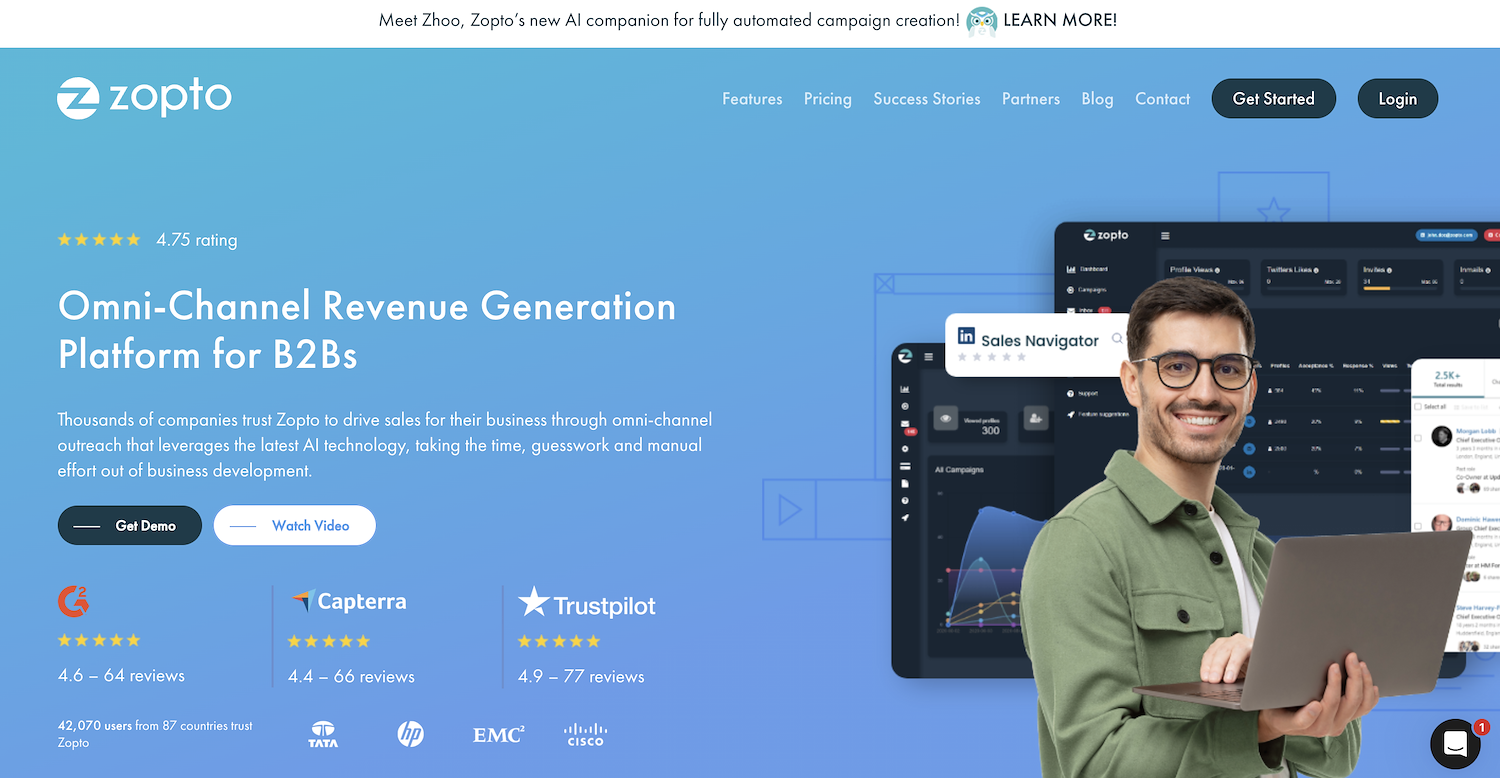
Zopto is an AI-powered, omni-channel platform for B2B organizations. It automates LinkedIn and email outreach, uses GPT-4 to create and manage campaigns, and supplies real-time analytics so teams can scale lead generation.
Use cases include outbound lead generation, account-based marketing, and event follow-up. The platform is built for B2B sales teams, individual SDRs, and agencies that manage client accounts.
Zopto's Main Features
- Builds end-to-end campaigns, writes templates, and auto-responds in the inbox with its GPT-4 based Zhoo AI assistant.
- Combines LinkedIn actions like invites and InMails with up to 5,000 verified email sends per month in omnichannel smart sequences.
- Automates and personalizes social posts using a LinkedIn post scheduler and a ChatGPT-4 content generator.
- Offers advanced filtering with hundreds of data points and uses AI to scrub lists for accuracy.
How Zopto Compares To Salesflow
Average Review Score: 4.5/5 stars based on 71 G2 reviews.
- Zopto includes a GPT-4 AI assistant that creates campaigns and handles auto-responses, offering a different approach than Salesflow's direct automation rules.
- Its omnichannel sequences combine LinkedIn actions with up to 5,000 verified email sends monthly, while Salesflow centers its automation mainly on LinkedIn.
- The platform offers a LinkedIn post scheduler with a built-in content generator, a social selling feature not standard in Salesflow's toolset.
- Unlike Salesflow, where some users note occasional data accuracy issues, Zopto uses AI to clean contact lists and provides advanced filtering options.
Where Zopto Falls Short Compared To Salesflow
- Some users report that Zopto can be slow, which may delay outreach campaigns. In contrast, Salesflow often provides more consistent performance as it focuses solely on LinkedIn automation.
- User reviews indicate Zopto has a high perceived cost. This differs from Salesflow, which is often described as a more affordable option for dedicated LinkedIn prospecting.
- The platform's omnichannel features may add complexity for teams that only need LinkedIn tools. Salesflow offers a simpler user experience with its singular focus on LinkedIn automation.
Pricing and Budget Considerations
While neither tool offers public pricing, user reviews indicate Zopto has a higher perceived cost. For the most accurate and up-to-date pricing information, we recommend visiting Zopto's official website.
3) Meet Alfred
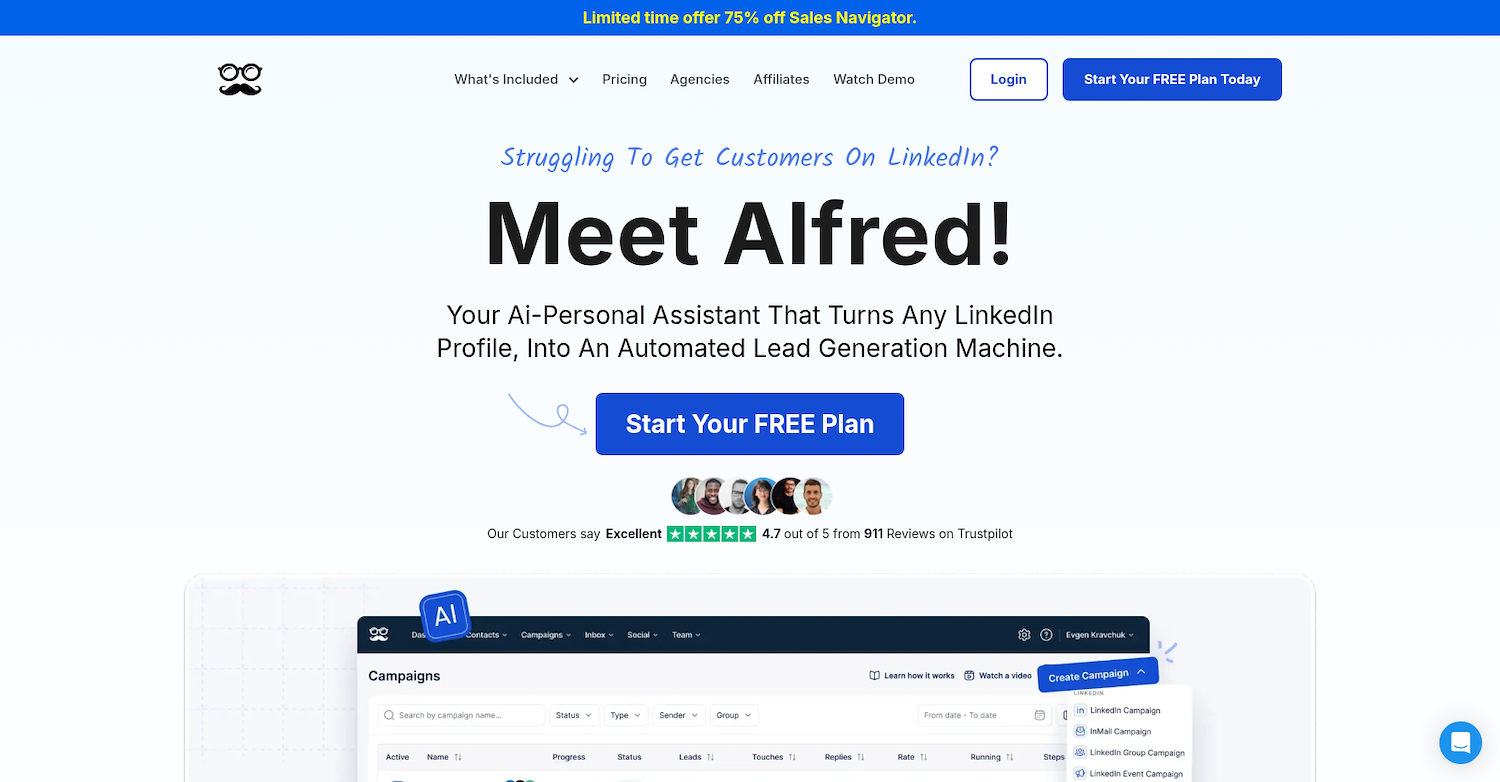
Meet Alfred is an outreach platform that automates tasks on LinkedIn, Email, and X (Twitter). As a virtual sales representative, it finds leads, sends personalized follow-ups, and manages conversations for sales teams.
Use cases include automated LinkedIn connection requests and multi-step follow-ups. The tool combines these actions with email and Twitter touchpoints in a single campaign, so teams can focus on deal closure.
Meet Alfred's Main Features
- Combines LinkedIn, email, and X (Twitter) outreach into a single, multi-step campaign sequence.
- Includes a built-in LinkedIn CRM to manage and grow your professional network directly within the platform.
- Provides a unified smart inbox with labels, notes, and filters to manage conversations from all channels.
- Offers a social media post scheduler to plan and automate content on your social profiles.
How Meet Alfred Compares To Salesflow
Average Review Score: 3.3/5 stars based on 32 G2 reviews.
- Meet Alfred combines LinkedIn, email, and X (Twitter) outreach into a single campaign, while Salesflow primarily focuses on LinkedIn automation.
- The platform provides a unified inbox to manage conversations from all channels. This is different from Salesflow, whose inbox is centered on LinkedIn interactions.
- It includes a built-in LinkedIn CRM to manage your network directly within the tool, offering an alternative to Salesflow's campaign management features.
- A social media post scheduler automates content on your profiles, a social selling feature not standard in Salesflow's toolset.
Where Meet Alfred Falls Short Compared To Salesflow
- Some users report that Meet Alfred's automation can trigger LinkedIn detection, which may risk account restrictions. Salesflow's dedicated focus on LinkedIn generally offers a more stable integration without these reported issues.
- Meet Alfred may impose campaign quotas that limit outreach volume, according to user reviews. In comparison, Salesflow provides campaign management tools built to scale LinkedIn prospecting without such defined restrictions.
- The platform's multi-channel features can sometimes introduce sequence issues or errors. Salesflow's singular focus on LinkedIn typically provides more consistent performance for teams that only need outreach on one platform.
Pricing and Budget Considerations
While we've covered key features and use cases in this comparison, pricing models can vary significantly between tools. For the most accurate and up-to-date pricing information, we recommend visiting Meet Alfred's official website.
4) Phantombuster
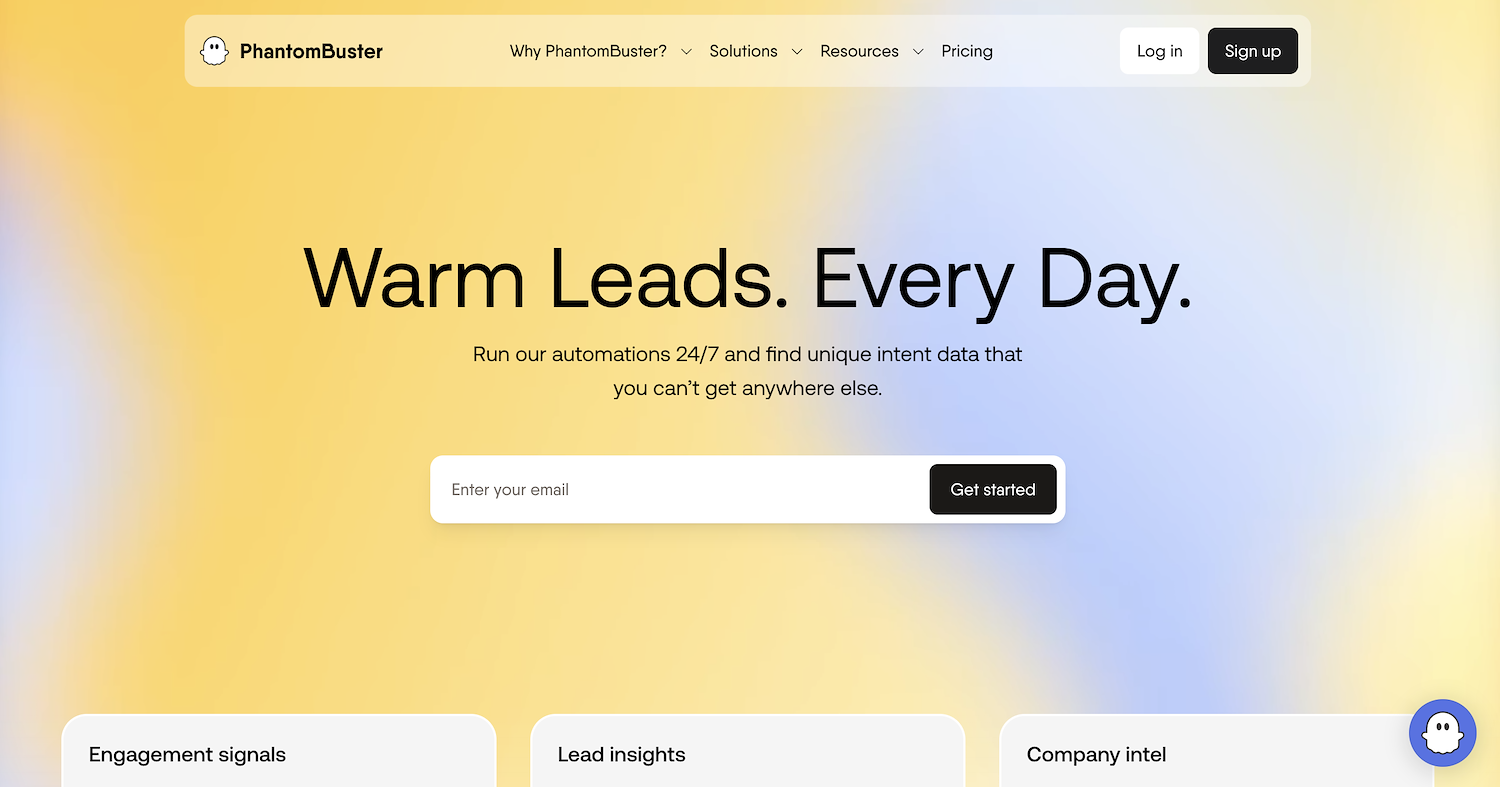
Phantombuster is a data extraction and automation tool. It uses individual automations, called Phantoms, to perform tasks across websites and social media platforms. Use cases include lead generation, contact data enrichment, and audience development for sales teams.
The platform automates repetitive actions to help users collect data for their outreach efforts.
Phantombuster's Main Features
- Deploys individual automations, called Phantoms, to perform specific tasks like scraping profiles or sending messages.
- Extracts data from a wide range of websites and social media platforms to build targeted lead lists.
- Connects different Phantoms to create custom workflows that automate repetitive data collection and enrichment tasks.
How Phantombuster Compares To Salesflow
Average Review Score: 4.3/5 stars based on 97 G2 reviews.
- Phantombuster extracts data from various platforms including Twitter, Instagram, and Google Maps. This offers more data sources compared to Salesflow, which centers on LinkedIn.
- The tool uses individual automations, called Phantoms, for specific tasks. This allows for building custom workflows, which provides a different level of flexibility compared to Salesflow's campaign management.
- Its core function is data extraction across the web to build targeted lists. This contrasts with Salesflow's primary focus on automating LinkedIn outreach sequences.
- Users can connect different Phantoms to create custom workflows for data collection. This offers a more modular approach to automation than the integrated campaign sequences in Salesflow.
Where Phantombuster Falls Short Compared To Salesflow
- Phantombuster requires users to connect individual automations to build workflows. This approach can be less direct for campaign management compared to the integrated tools Salesflow provides for outreach.
- Its automations can sometimes break when social media platforms update their sites. Salesflow, with its dedicated focus on LinkedIn, generally offers a more stable integration for prospecting on that platform.
- The tool may present a learning curve for users who need to build complex workflows. In contrast, Salesflow is often described as a more straightforward platform for teams that only need LinkedIn automation.
Pricing and Budget Considerations
Salesflow is described as an affordable tool, while user reviews indicate Phantombuster has a high perceived cost. For the most accurate and up-to-date pricing information, we recommend visiting Phantombuster's official website.
5) Dux-Soup

Dux-Soup is a browser extension that automates lead generation on LinkedIn. It works with your browser to visit profiles, endorse skills, and send connection requests. The tool helps sales teams find and engage prospects directly on the platform.
Use cases include automated prospect discovery and outreach campaigns. It allows users to manage lead generation from a dashboard and tag profiles for follow-up. This supports a systematic approach for prospect outreach on LinkedIn.
Dux-Soup's Main Features
- Works directly inside LinkedIn, Sales Navigator, or Recruiter, which preserves account safety and activity history.
- Sends connection invites and InMails with custom time delays and automatically removes prospects from campaigns once they reply.
- Pushes new leads to CRMs like Salesforce and HubSpot through native integrations as well as Zapier and Make.
- Offers a browser extension for on-device automation and a cloud edition for always-on operation from any location.
How Dux-Soup Compares To Salesflow
Average Review Score: 4.3/5 stars based on 82 G2 reviews.
- Dux-Soup operates as a browser extension that works directly within LinkedIn. This is different from Salesflow, which is a separate cloud-based platform.
- It offers both a browser extension for on-device automation and a cloud edition for continuous operation. This provides more flexibility than Salesflow's single platform approach.
- The platform allows users to send LinkedIn campaigns directly to contacts within their CRM. This differs from Salesflow, where campaigns are typically managed inside the Salesflow platform itself.
- The tool works inside the browser to mimic human behavior with custom time delays. This approach is designed for account safety, offering an alternative to Salesflow's platform-based automation.
Where Dux-Soup Falls Short Compared To Salesflow
- Dux-Soup's campaign management can be rigid. Some users report that it is difficult to edit messages after a campaign starts. In comparison, Salesflow offers more direct control over active outreach sequences.
- The tool lacks a native team campaign feature in its cloud version, which can complicate collaboration. Salesflow, by contrast, designs its platform for team use with shared dashboards and campaign management.
- Some users find the user experience less intuitive than other platforms. Salesflow is often noted for its straightforward design, which may provide a simpler workflow for teams focused purely on LinkedIn prospecting.
Pricing and Budget Considerations
Dux-Soup offers transparent pricing with multiple tiers, including Pro Dux ($11.25/month), Turbo Dux ($41.25/month), and Cloud Dux ($74.17/month). While Salesflow does not have a public price list, it is often described as an affordable option, making Dux-Soup's entry-level plan a budget-friendly choice for basic automation.
Explore Digital Workers With 11x
For teams interested in autonomous sales functions, 11x offers a practical solution. Its AI agents manage prospecting and outreach. This frees up your sales team to focus on high-value activities like closing deals and building client relationships.
With 11x, AI agents execute the sales process. Alice identifies accounts, enriches data, and manages outreach. Julian handles inbound calls, qualifies leads, and books meetings. The platform unifies tools for data, outreach, and email warmup, removing the need for separate solutions.
Book a demo to see how the AI agents operate.
6) Linked Helper

Linked Helper is a LinkedIn automation tool that works as a standalone application to build sales funnels. It sends personalized connection requests and message sequences to prospects. The tool also has a built-in CRM for contact management.
Use cases include outreach to 2nd and 3rd-degree connections and the creation of drip campaigns to warm up leads for sales teams.
Linked Helper's Main Features
- Stores every processed contact, tag, note, and full interaction history in a built-in CRM.
- Uncovers up to 95% of emails for 2nd and 3rd-degree connections using an email finder with included monthly credits.
- Simulates human-like browser behavior with randomized timeouts and custom working hours for safety.
- Builds audiences from multiple sources, including Sales Navigator, Recruiter, CSV files, and post engagers.
How Linked Helper Compares To Salesflow
Average Review Score: 4.6/5 stars based on 144 G2 reviews.
- Linked Helper operates as a standalone browser application that mimics human actions like clicks and typing. This approach is designed for account safety and differs from Salesflow's cloud-based platform model.
- The tool includes a built-in email finder that uncovers contact information for 2nd and 3rd-degree connections, providing an additional data source compared to Salesflow's primary focus on LinkedIn.
- It offers direct integrations with CRMs like Hubspot and Pipedrive, which allows for a different workflow than managing campaigns primarily within the Salesflow platform.
- Its message template editor supports custom variables, conditional logic, and image attachments, offering more advanced personalization options than the standard messaging features in Salesflow.
Where Linked Helper Falls Short Compared To Salesflow
- Linked Helper is a local application, so campaigns run on your computer. This is different from Salesflow's cloud-based model, which allows campaigns to run continuously without depending on a local machine.
- The tool's design can make team collaboration less direct. In contrast, Salesflow provides a cloud platform with shared dashboards specifically built for team-based campaign management.
- Some users report a learning curve due to its extensive features. Salesflow offers a more focused user experience for LinkedIn automation, which can be simpler for teams to adopt quickly.
Pricing and Budget Considerations
Linked Helper provides transparent pricing with a Standard plan at $15 per month and a PRO plan at $45 per month. While Salesflow does not have a public price list, Linked Helper’s entry-level plan offers a clear and budget-friendly option for basic automation needs.
7) Octopus CRM
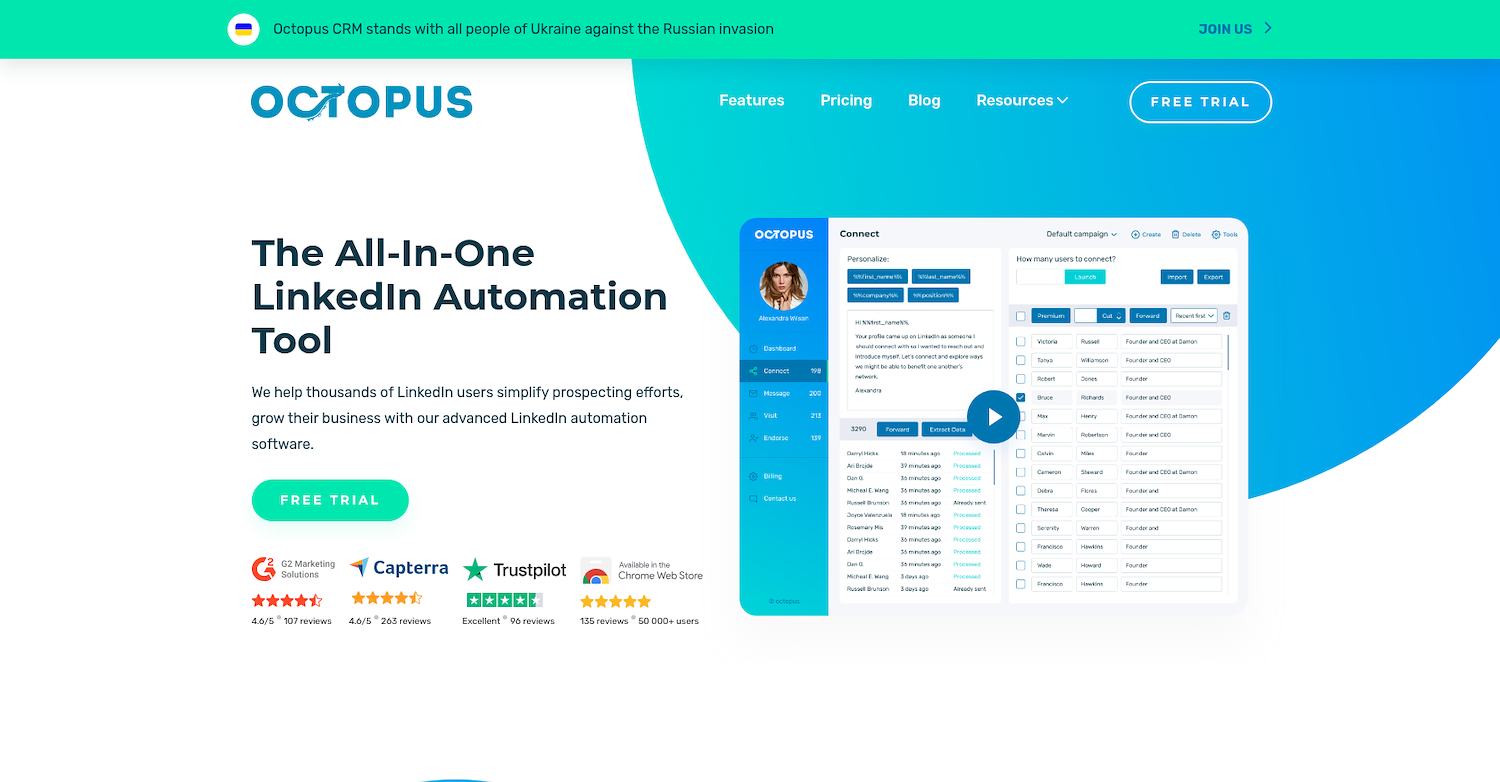
Octopus CRM is an automation tool for LinkedIn that helps sales teams find and engage with prospects. It allows users to build sales funnels with automated message campaigns and connection requests. The platform is designed for lead generation and prospect management on LinkedIn.
Use cases include outreach to 1st, 2nd, and 3rd-degree connections and the creation of drip campaigns to warm up leads for sales teams.
Octopus CRM's Main Features
- Bypasses LinkedIn’s weekly invite limit by sending connection requests via email.
- Sends bulk messages to hundreds of 1st-degree connections.
- Automatically visits profiles and endorses up to seven skills for each contact.
- Builds multi-step LinkedIn funnels with a drag-and-drop campaign builder.
How Octopus CRM Compares To Salesflow
Average Review Score: 4.4/5 stars based on 116 G2 reviews.
- Octopus CRM sends connection requests via email to bypass LinkedIn’s weekly invite limit. This provides a different way to expand outreach volume compared to Salesflow's standard campaign management.
- The tool includes a personal analytics page that tracks daily performance and campaign conversion rates. This gives users more detailed metrics than the general campaign features in Salesflow.
- It sends bulk messages to hundreds of 1st-degree connections at once. This function lets users engage a large, existing network, which differs from Salesflow's sequence-based automation.
- The platform automatically endorses up to seven skills for each contact. This adds a personal touch to outreach, a feature not standard in Salesflow's toolkit.
Where Octopus CRM Falls Short Compared To Salesflow
- Octopus CRM uses a split interface between its web app and browser extension, which sometimes complicates team workflows. Salesflow, in contrast, is a unified cloud platform with shared dashboards designed for team use.
- Its reporting features are sometimes found to be less detailed. Salesflow's campaign management tools usually offer more in-depth analytics, giving teams a clearer view of performance.
- The tool may require add-ons for some multi-step automation features. In contrast, Salesflow integrates complex campaign sequences directly into its platform, so no extra components are needed.
Pricing and Budget Considerations
Octopus CRM provides transparent pricing, with plans from $6.99 to $24.99 per month. Salesflow does not publish its prices but is generally considered affordable. This makes Octopus CRM's model predictable for teams, while Salesflow likely requires direct inquiry for a quote.
8) We-Connect

We-Connect is a cloud-based platform that automates LinkedIn tasks for sales teams, marketers, and recruiters. It supports lead generation through automated sequences for prospect outreach. The tool allows for the management of multiple accounts to facilitate team use.
We-Connect's Main Features
- Monitors leads and captures data from social media and websites.
- Offers analytics and reporting to track campaign performance.
- Includes customization through templates, personalization, and forms.
- Supports data export and import for contact management.
How We-Connect Compares To Salesflow
Average Review Score: 4.6/5 stars based on 83 G2 reviews.
- We-Connect captures data from social media and websites, offering broader lead monitoring than Salesflow, which centers on LinkedIn.
- The platform includes customization through forms, which allows for a different type of lead capture compared to Salesflow's standard campaign interactions.
- It provides dedicated analytics and reporting features to track campaign performance, offering a more focused view of metrics than the general campaign tools in Salesflow.
- This tool supports data export and import for contact management, giving users more flexibility to move lists between systems than Salesflow's platform-centric approach.
Where We-Connect Falls Short Compared To Salesflow
- Some users note that We-Connect's platform can feel slow or have a poor design. This is different from Salesflow, which users often praise for its ease of use and straightforward interface that supports quick campaign setup.
- The tool's campaign management features can feel limited for complex sequences. Salesflow, in contrast, provides more advanced tools to manage and scale intricate LinkedIn prospecting campaigns without similar restrictions.
- While We-Connect supports multiple accounts, its team collaboration features are less integrated. Salesflow offers a unified platform with shared dashboards, which simplifies how teams manage campaigns together.
Pricing and Budget Considerations
We-Connect offers transparent pricing with a Starter plan at $69 per month and a Professional plan at $79 per month. Salesflow does not publish its prices, though it is often described as an affordable tool. This makes We-Connect's costs predictable, while a direct comparison with Salesflow requires obtaining a quote.
9) Skylead

Skylead is a sales engagement platform that automates outreach. It combines LinkedIn actions and email messages into smart sequences. The tool helps sales teams and agencies generate leads.
Use cases include outbound campaigns to find prospects and personalized outreach to book meetings. The platform builds multi-channel communication flows for sales development.
Skylead's Main Features
- Combines LinkedIn and email actions with if/else conditions into a single smart sequence.
- Discovers and double-verifies business emails to help reduce bounce rates, even for leads not connected on LinkedIn.
- Personalizes messages with unique images and GIFs to increase reply rates.
- Manages all lead responses from multiple channels in a unified smart inbox.
How Skylead Compares To Salesflow
Average Review Score: 4.5/5 stars based on 126 G2 reviews.
- Skylead combines LinkedIn and email outreach using smart sequences with if/else conditions. This provides more flexible communication paths than the LinkedIn-focused sequences in Salesflow.
- The platform includes a built-in email finder to discover and verify business emails for contacts. This is different from Salesflow, which primarily works with data available on LinkedIn.
- It personalizes messages with unique images and GIFs to help increase reply rates. This offers a visual engagement method not standard in Salesflow's text-based automation.
- A unified smart inbox centralizes lead responses from both LinkedIn and email. In comparison, Salesflow's inbox is designed to manage LinkedIn interactions only.
Where Skylead Falls Short Compared To Salesflow
- Skylead’s onboarding can be tricky for new users, according to some reviews. This contrasts with Salesflow, which is often noted for its simple interface and quick setup for LinkedIn-only campaigns.
- The tool's omnichannel features might add complexity for teams that only need LinkedIn automation. In contrast, Salesflow offers a more focused user experience centered entirely on LinkedIn prospecting.
- Some users note occasional delays in email delivery, which can affect outreach timing. Salesflow's singular focus on LinkedIn generally provides more consistent performance for its automated sequences.
Pricing and Budget Considerations
Skylead offers a transparent All-In-One plan at $100 per month. Salesflow does not publish its pricing, but it is often described as an affordable option, so a direct quote is necessary for a precise comparison.
10) Reply.io
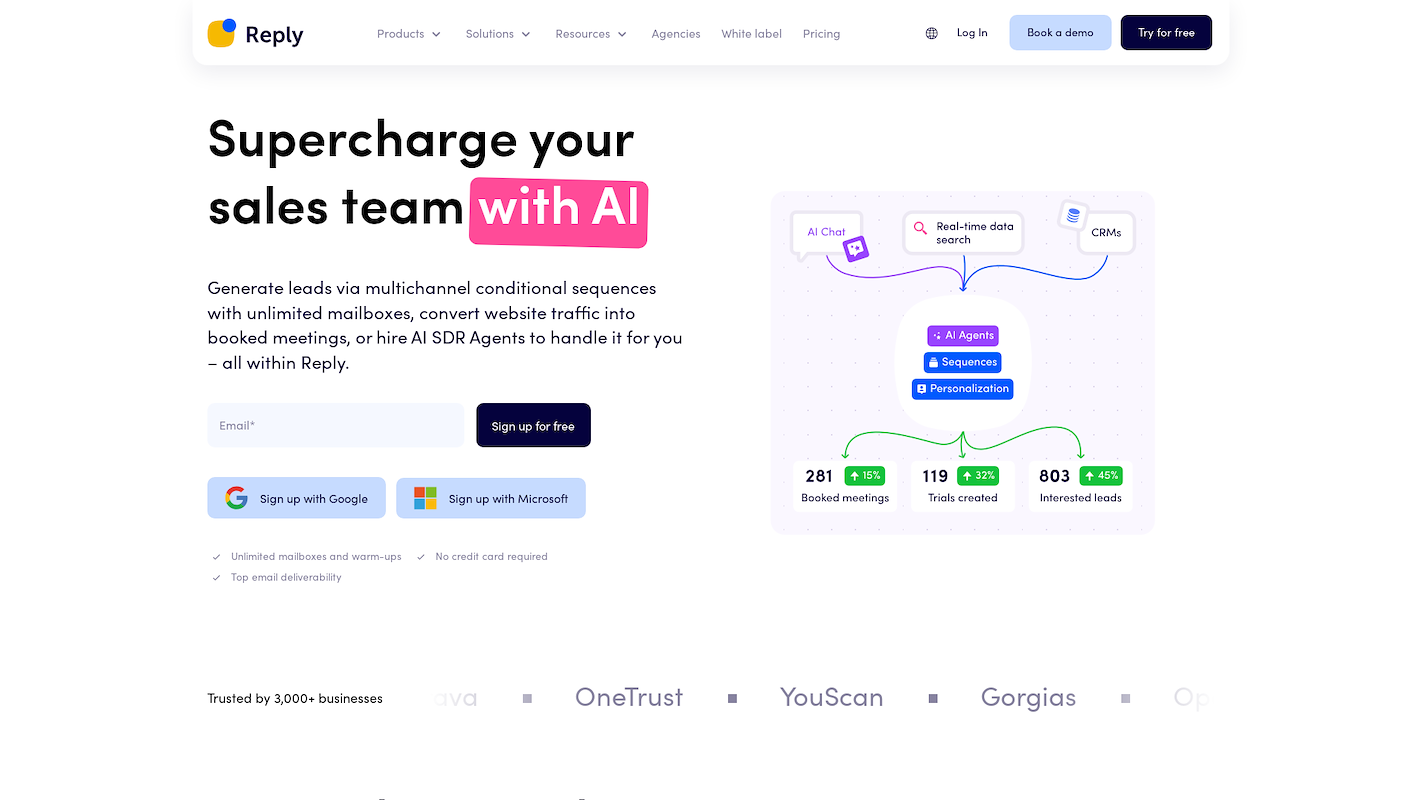
Reply.io is a sales engagement platform that automates outreach across multiple channels. It helps sales teams manage communication with prospects through email, LinkedIn, and social media. The platform allows users to build and execute contact sequences.
Use cases include outbound sales and account-based marketing. The tool helps teams find prospects, engage them through LinkedIn outreach, and book meetings.
Reply.io's Main Features
- Combines emails, LinkedIn touchpoints, WhatsApp, SMS, and calls into dynamic, conditional sequences.
- Deploys AI SDR agents to automate sales outreach, from finding prospects to handling responses.
- Captures website visitors with a sales-trained AI chat that uses video avatars to book meetings.
- Provides an email deliverability suite with SPF, DKIM, and DMARC monitoring and email warm-up features.
How Reply.io Compares To Salesflow
Average Review Score: 4.6/5 stars based on 1,458 G2 reviews.
- Reply.io combines emails, calls, SMS, and WhatsApp into its sequences. This offers more communication channels compared to Salesflow, which focuses its automation on LinkedIn.
- The platform deploys AI SDR agents to automate the sales process from prospecting to response handling. This provides a different level of automation than the direct campaign rules found in Salesflow.
- It includes an AI chat with video avatars for websites to capture and qualify visitors. This is a lead generation feature for web traffic that Salesflow does not offer.
- The tool provides an email deliverability suite with warm-up and monitoring features. This supports email-heavy campaigns, an area where Salesflow is less specialized.
Where Reply.io Falls Short Compared To Salesflow
- Some users report a learning curve with Reply.io due to its extensive features. In contrast, Salesflow offers a more direct user experience for teams that need only LinkedIn automation.
- The platform's LinkedIn automation can sometimes perform with a delay. Salesflow, with its dedicated focus, generally provides a more stable integration for campaigns on that platform.
- Its broad, multi-channel approach might add complexity for teams that require only LinkedIn tools. Salesflow presents a simpler, more focused solution for this specific use case.
Pricing and Budget Considerations
Reply.io provides transparent pricing with a free plan, an email-focused plan starting at $49 per user per month, and a multichannel plan from $89. While Salesflow does not publish its prices, Reply.io's free tier offers a no-cost entry point for basic needs.
Which One Should You Go With?
Many variables influence the choice of a Salesflow alternative, from budget to required features. This guide reviewed several options to help you find a suitable tool for your sales team's specific needs.
For teams exploring autonomous sales functions, 11x provides AI agents that manage prospecting and outreach. This approach allows your sales team to focus on closing deals and building client relationships instead of manual tasks.




